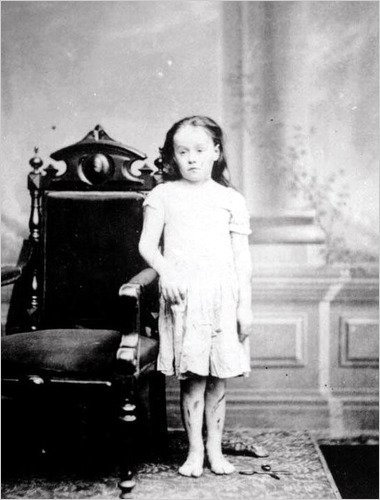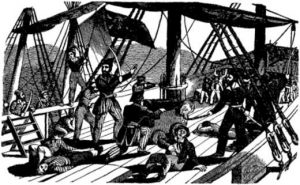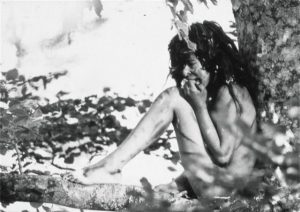“The frail child in the tattered dress stands next to a large carved wooden chair, her hand resting on the arm for support. A large gash runs from her forehead to her cheek; her arms and legs are evidence of repeated and severe abuse.”1 It’s easy to assume that this came straight from the script of a horror movie, but it was the harsh reality for young Mary Ellen Wilson, a nine year old girl who was so beaten up and malnourished that she only looked about half her age. Although the worst part about it was that her guardian, the person that was expected to provide love and care, was the perpetrator of this little girl’s tortured condition, and law enforcement was only able to help with one hand tied behind its back. Help for children like Mary Ellen was hard to come by because, in the year 1874, parents could raise and discipline their children as they pleased. Parents of the time lived with the mindset that the government had no right to interfere with their parenting, but the Mary Ellen Wilson case opened the eyes of many, including Henry Burgh, who initiated a change and put together a team to end the violence.2
Before 1874, no one had actually ever seen young Mary Ellen. She lived in isolation for at least six out of the nine years of her lifetime. Luckily, her suffering was brought to light when neighbors reported the crying of a child without ever actually seeing the child. Due to the lack of child protection laws, there was not much officials could do about the situation. But once missionary Etta Wheeler caught wind of what was going on, she was determined to rescue Mary Ellen. Etta Wheeler is often overlooked when the Mary Ellen Wilson story is told, but without her kind efforts, Mary Ellen may have never gotten the help she needed.3
Wheeler paid many visits to Mary Ellen’s home, most of which were unsuccessful. and she was only able to catch short glimpses of the battered child. She then requested help from local organizations and charities that were known for providing essentials for children in need, but they did not possess the authority to intervene. Finally, Wheeler turned to someone who was known to take action for causes that he believed in, Henry Burgh.4
Henry Burgh was a rich, well-known diplomat famous for being the founder of the American Society for the Prevention of Cruelty to Animals and for getting overwhelmingly involving in things that he believed in. After working with Wheeler to learn more about Mary Ellen’s situation, he reached out to attorney Elbridge T. Gerry. Gerry was eager to get the ball rolling as well, and within 48 hours, Gerry and Burgh had developed a case and asked Wheeler to testify.5 In attempts to gather more information of his own, Burgh sent investigators to Mary Ellen’s home. After seeing the horrific conditions that Mary Ellen was in, law enforcement soon made the decision to remove the young girl from the dangerous home. Although there were no specific laws concerning child abuse, these circumstances were so special and concerning that an executive decision was made. They took the young, battered girl out of her death trap of a home and comforted her in a blanket. She was so oblivious to the outside world that when a police officer gave her a peppermint stick for comfort, she tried to use it for self defense.6

It was now time for Mary Ellen’s case to go to court, and who better to tell the Mary Ellen story than Mary Ellen herself? She was able to testify for herself in cour,t and gave the real and terribly sad testimony that follows: “My name is Mary Ellen…I have no recollection of ever having been kissed and I have never been kissed by momma. I have never been taken on mommas lap…I never dared speak to anybody, because if I did I would get whipped; I have never had any more clothing than I have on at present…;I have seen stockings and other clothes in our room, but I am not allowed to put them on; whenever momma went out, I was locked up in the bed- room;…I don’t know for what I was whipped; momma never said anything when she whipped me; I do not want to go back to live with momma because she beats me so.”7
After a legal battle, Mary Ellen was permanently removed from her home and given her justice, but this was not enough for Henry Burgh. Burgh was determined to create an organization to protect future children from that kind of abuse. He quickly founded The New York Society for the Prevention of Cruelty to Children (NYSPCC). NYSPCC was the first child protective organization in the entire world. It has since influenced over 300 different organizations and eventually it led to the development of Child Protective Services.8
- Mary Renck Jalongo, “The Story of Mary Ellen Wilson: Tracing the Origins of Child Protection in America,” Early Childhood Education Journal, Vol. 34, no.1 (August 2006): 1. ↵
- Howard Markel, “Case Shined First Light on Child Abuse,” New York Times, December 14, 2009, http://www.nytimes.com/2009/12/15/health/15abus.html. ↵
- Gerald Mallon, “From the Editor: The Legend of Mary Ellen Wilson and Etta Wheeler: Child Maltreatment and Protection Today,” Child Welfare vol. 92, no.2 (March 2013): 9. ↵
- John E.B. Myers, “A Short History of Child Protection in America,” Family Law Quarterly, Volume 42, no.3 (Fall 2008): 451. ↵
- Mary Renck Jalongo, “The Story of Mary Ellen Wilson: Tracing the Origins of Child Protection in America,” Early Childhood Education Journal, Vol. 34, no.1 (August 2006): 2. ↵
- Eric Shelman, The Mary Ellen Wilson Child Abuse Case and the Beginning of Children’s Rights in 19th Century America (Jefferson, N.C. : McFarland & Company, 2005), 16. ↵
- Mary Renck Jalongo, “The Story of Mary Ellen Wilson: Tracing the Origins of Child Protection in America,” Early Childhood Education Journal, Vol. 34, no.1 (August 2006): 1. ↵
- John E.B. Myers, “A Short History of Child Protection in America,” Family Law Quarterly, Volume 42, no.3 (Fall 2008): 451-452. ↵



57 comments
Hannah Wilson
This was a short article but still very well-written. It also makes you feel good about humanity because numerous people took this little girls suffering to heart and helped her get out of it. they then immediately turned to helping others. The story is very sad that someone could treat their own daughter like that, but this isn’t an issue from the past. It happened every day. I would have liked to know what happened to Mary Ellen after she got out.
Samuel Stallcup
The article did a good job of giving the details necessary to describe Mary Ellen’s situation: lack of food, constant whips, and a lackluster mother. It’s truly horrifying that all this child knew about until she was nine was how it felt to be whipped and have hardly any food in her. It’s unfortunate that someone had to go through this just for laws to be passed in the United States. Good article!!
Erin Vento
It’s so heartbreaking to read the testimony of a child that is literally asking to leave her mother because the mother doesn’t know how to be a mother to her child. I’m so glad that this story had a good ending and that this case inspired an organization aimed to help children of abuse. It’s not an extinct topic and so many kids are still abused by their parents today, but it’s sad to think that there was hardly anything they could initially do for Mary Ellen.
Anna Guaderrama
Honestly I never really put much thought to the idea of child abuse till I started working at my local YMCA as a Child Watch Attendant. By company regulation, I was required to take a Child Abuse Prevention class in order to become certified before getting the job. During this training they actually started off with talking about Mary Ellen Wilson as a sort of introduction into the program that left me in awe. I’ve always had a soft spot for children and the idea of anyone intentionally trying to hurt a child is beyond me. Regardless of what most of my friends think, I believe they’re the future of tomorrow and deserve a childhood filled with joy, understanding, and love. Upon reading this article, it actually brought tears to me to read about how anyone could something so vile to anyone indefensible and innocent. Although I’m glad this article was written to shine some light on the story, child abuse, and the contributions of Eta Wheeler and Henry Burgh I do wish the article would have talked more about some of the emotional and psychological aspects that affected Ms. Mary. But overall, I enjoyed this article and the only part that really touched me was “They took the young, battered girl out of her death trap of a home and comforted her in a blanket. She was so oblivious to the outside world that when a police officer gave her a peppermint stick for comfort, she tried to use it for self defense”. To really take child abuse in perspective I believe this quote really hits the feelings these children go through.
Alexandra Lopez
It is truly tragic that an inhumane act like this had to happen before any child protection movements fell into place. Abuse to that poor, innocent little Mary Ellen was extremely heartbreaking. Reading this makes my heart swell with sadness. I don’t understand how someone can do that to their own child. It’s ridiculous. If a parent is mentally unstable, they shouldn’t be allowed to care for children. The effects absuivness leaves on children damages them up to their adulthood.
Saira Castellanos
I have the biggest soft spot for kids in my heart. Reading things like this makes me want to cry. I am glad that people like Henry that make such corporations to help those in need. Some children deserve much more than what they are getting and other children get too much and then feel entitled to things. I wish people had to go to college in order to prove that they are mentally stable to have a child. I feel like this would decline the crime rate by a lot. Not everyone should have a child, and children most certainly should not suffer just because a parent is mentally unstable or any other reason.
Natalia Flores
This sort of abuse shouldn’t happen in any part of modern society. It makes me sick to think that there is a person who would whip and beat their own child. To add to that is that this article doesn’t really mention children that are outside their abusive homes and whether they go to a home that is healthy. Not to mention the psychological effects these children will suffer from for the rest of their lives. It’s a shame this article mentions very little of that.